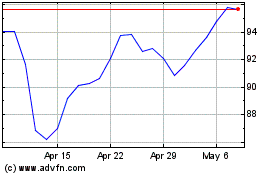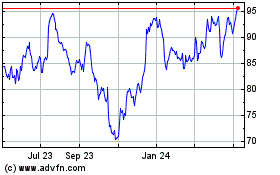By Liz Hoffman
Morgan Stanley said its quarterly earnings rose 70%, riding big
boosts in its debt-trading and underwriting businesses to become
the last of the big Wall Street banks to post strong numbers.
Notably, the firm's results, especially in fixed-income trading,
were far stronger than those of arch rival Goldman Sachs Group
Inc.
Morgan Stanley's shares climbed 2.4% premarket as earnings and
revenue beat Wall Street estimates. The firm reported a profit of
$1.93 billion, or $1 a share. That compares with $1.13 billion, or
55 cents a share, in the first quarter of 2016, which was a dismal
one for big banks.
Revenue grew 25% to $9.75 billion. Analysts polled by Thomson
Reuters had expected 88 cents a share in earnings on revenue of
$9.27 billion.
The biggest surprise was $1.7 billion in revenue from
fixed-income trading, which includes corporate and government
bonds, currencies and commodities. Long a trouble spot for Morgan
Stanley, the unit is showing steady progress after a leadership
change last year, and this quarter outearned Goldman, which
reported disappointing trading figures Tuesday.
Morgan Stanley's return on equity, a closely watched measure of
profitability, was 10.7% in the quarter, finally clearing -- at
least on a quarterly basis -- the 10% target laid out by Chief
Executive James Gorman.
"In these types of markets our business performs well," Chief
Financial Officer Jonathan Pruzan said in an interview. "We clearly
have to prove it the rest of the year."
Few firms on Wall Street benefit more from the combination of
rising interest rates and a rising stock market than Morgan
Stanley, whose wealth management division manages trillions of
dollars of client money across stocks, bonds and other assets.
Nearly every one of its businesses posted stronger numbers: a
near-doubling of fixed-income trading revenue, a record profit
margin in wealth management driven by loan growth and higher
interest rates, and a 131% increase in underwriting fees.
Meanwhile, the firm kept a lid on costs, which ticked up just
$100 million, excluding pay, while revenue grew $1.4 billion.
The compensation ratio in its core investment-banking and
trading businesses was 36%, below the 37% ceiling Mr. Gorman laid
out a year ago. In wealth management, where brokers take home far
more of what they bring into the firm, the figure was 57%, above
the goal of 56%.
"Solid as a rock," Steven Chubak, an analyst with of Instinet,
wrote of Morgan Stanley's earnings.
The wealth-management business posted a 24% profit margin, the
highest since Morgan Stanley bought Smith Barney after the
financial crisis.
One factor was an 18% increase in interest income, the fruits of
a push across the brokerage business to lend more. Mr. Pruzan said
loan growth was split roughly evenly across the bank's three main
products: mortgages, loans backed by securities portfolios, and
tailored loans secured by art, jewelry, hedge-fund stakes and other
illiquid valuables.
The shift toward managing the portfolios of millions of
Americans is part of Mr. Gorman's plan, now a few years under way,
to move Morgan Stanley away from volatile trading and into
businesses whose fees don't swing around as much with the
market.
Still, the past few months have been challenging in other Morgan
Stanley core businesses. Stock-trading, where it is Wall Street's
leader, has grappled with lower commissions and more money moving
to passive managers that trade less often. Revenue in that division
fell 1.9% to $2.02 billion.
But a bright spot was debt-trading, where revenue nearly doubled
to $1.71 billion. The business has now posted four straight
quarters of at least $1 billion in revenue after Mr. Gorman
reorganized the business and shifted two top equities traders to
oversee it.
Mr. Pruzan said that corporate bonds, interest-rate products and
commodities were busy, while foreign-exchange was slower.
Total sales and trading revenue was $3.5 billion, up 30% from
the first quarter of 2016, which was notably weak for Wall Street
trading desks.
Investment banking revenue, which include advisory and
underwriting fees, rose 43% to $1.42 billion. Triple-digit gains in
underwriting more than offset a 16% decline in M&A fees, though
Mr. Pruzan said the firm's merger pipeline is higher that it was
this time in 2016, which ended up being a record for global deal
making.
Morgan Stanley's shares are down 2.5% this year, having given up
about half of their postelection gains.
Write to Liz Hoffman at liz.hoffman@wsj.com
(END) Dow Jones Newswires
April 19, 2017 08:51 ET (12:51 GMT)
Copyright (c) 2017 Dow Jones & Company, Inc.
Morgan Stanley (NYSE:MS)
Historical Stock Chart
From Mar 2024 to Apr 2024

Morgan Stanley (NYSE:MS)
Historical Stock Chart
From Apr 2023 to Apr 2024
